What is “I’m a hacker who hacked your operating system” Email Scam?
I’m a hacker who hacked your operating system email is an online sextortion scam. Sextortion is another word for “sexual extortion”. Sexual extortion is a type of “phishing attack”, where scammers try to trick people into paying a ransom. Scammers threaten to reveal secretly recorded compromising video if the ransom is not paid.
Scammers use stolen email credentials to send out scam messages to millions of people around the World. The messages are sent to email addresses exposed in previous known data breaches in which the user email address and password has been compromised.
Sextortion scam emails may contain a genuine password from one of the victim’s accounts. Usually passwords are appended to these messages as proof, that is, if the password was actually used by the victim, then what is described in the email is true. Scammers get these real passwords by buying them on darknet.
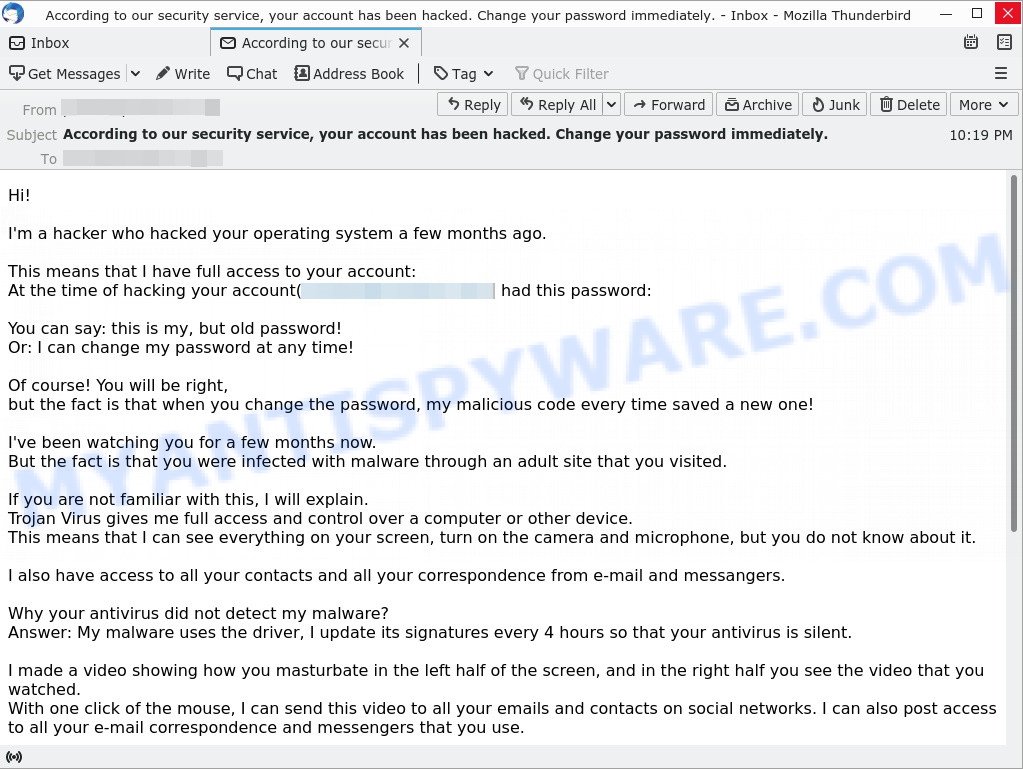
I’m a hacker who hacked your operating system Email Scam
QUICK LINKS
- What is “I’m a hacker who hacked your operating system” EMAIL?
- Should you pay?
- What to do when you receive the scam message?
- How to spot a phishing email?
- Report Scam Email
The Scam in detail
In this particular case, the scam email says that someone calling himself a hacker has been watching the victim, because the victim’s computer has a malware, which is a Trojan that allows the attacker to completely control the computer and even record video from the computer’s camera. The scam email claims that a video was recorded showing the victim masturbating while browsing porn sites. This video will be sent to the victim’s friends if the victim does not pay the ransom to the bitcoin address provided in the email.
The scam email is not the only one of its kind, there are many similar ones. They all have similar features: statement that the victim’s computer and webcam were hacked, threats that the attackers recorded a compromising video, and a ransom demand. Explanations that scammers use to explain how they have access to your camera and privacy:
- They set up malware on adult (porn) website.
- They penetrated with “zero-click” vulnerability on Zoom or Pegasus.
- They got your credentials (login and password) from hackers.
Depending on the scam email, victims are given 24 to 48 hours to pay a ransom in Bitcoin. The sextortion emails also contain claims that the victim’s contact information was stolen, allegedly the hacker copied the victim’s contact list and social media credentials. And finally, Sextortion scams contain threats, the victims must pay a ransom, or compromising materials will be sent to their contacts.
Typically, sextortion scams are sent via email, thousands at a time, and are part of larger spam campaigns. As with many other types of scams, scammers are evolving their methods to deliver their messages to potential victims. Such attacks can be personalized and sent out in smaller numbers to avoid detection. Scammers can use reputable services, change and personalize the content of each message, and avoid including links or attachments – all in an attempt to bypass security.
Text presented in the scam email:
Hi!
I’m a hacker who hacked your operating system a few months ago.
This means that I have full access to your account:
At the time of hacking your account(xxxxxxx@xxxxxxx.com) had this password:You can say: this is my, but old password!
Or: I can change my password at any time!Of course! You will be right,
but the fact is that when you change the password, my malicious code every time saved a new one!I’ve been watching you for a few months now.
But the fact is that you were infected with malware through an adult site that you visited.If you are not familiar with this, I will explain.
Trojan Virus gives me full access and control over a computer or other device.
This means that I can see everything on your screen, turn on the camera and microphone, but you do not know about it.I also have access to all your contacts and all your correspondence from e-mail and messangers.
Why your antivirus did not detect my malware?
Answer: My malware uses the driver, I update its signatures every 4 hours so that your antivirus is silent.I made a video showing how you masturbate in the left half of the screen, and in the right half you see the video that you watched.
With one click of the mouse, I can send this video to all your emails and contacts on social networks. I can also post access to all your e-mail correspondence and messengers that you use.If you want to prevent this, transfer the amount of $950 to my bitcoin address (if you do not know how to do this, write to Google: “Buy Bitcoin”).
My bitcoin address (BTC Wallet) is: 1AJ4syJxPPP7hYhURPiQUQMY4LurJgYvY8
After receiving the payment, I will delete the video and you will never hear me again.
I give you 48 hours to pay.
I have a notice reading this letter, and the timer will work when you see this letter.Filing a complaint somewhere does not make sense because this email cannot be tracked like my bitcoin address.
I do not make any mistakes.If I find that you have shared this message with someone else, the video will be immediately distributed.
Bye!
Should you pay?
The best advice is: Don’t pay the ransom and do not reply! Sometimes scammers will escalate if you reply. If you receive the sextortion email scam, just ignore the scammers. The best way to deal with the scam email is simply to move it to trash!
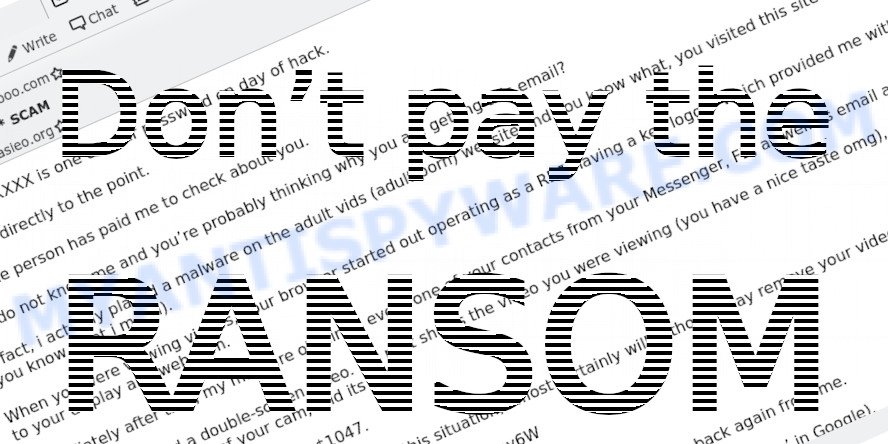
Threat Summary
| Name | I’m a hacker who hacked your operating system SCAM |
| Type | Sextortion, Phishing, Bitcoin Email Scam, Fraud, Scam |
| Ransom amount | $1450, $950 |
| Bitcoin Address | 1CRCqjGKgiNziUi9k5aqtbcLp3575BRQKB, 1AJ4syJxPPP7hYhURPiQUQMY4LurJgYvY8 |
| Distribution method | spam email campaigns |
| Removal | If you received an email saying i hacked your device, our computer security experts recommend follow the steps below |
Examples of such scams
There are many sextortion scams circulating via email. Scammers often change the content of emails in order to deceive victims and bypass the security system. I have e-mailed you from your account, Unfortunately, there are some bad news for you, I have to share bad news with you are other examples of sextortion scams. Such emails are also often used to distribute ransomware, trojans, worms and other malware.
- “There is an overdue payment under your name. Please, settle your debts ASAP.” message us a SCAM
- The “Sadly, there are some bad news that you are about to hear.” email is a SCAM
- FINAL WARNING email is a sextortion scam
- “Payment from your account.” email is a ‘sextortion’ scam
- “Don’t miss your unsettled payment. Complete your debt payment now.” email is a SCAM
What to do when you receive the I’m a hacker who hacked your operating system Scam Email
We advice to someone who gets this fraudulence message:
- Do not panic.
- Do not pay a ransom.
- Do not reply.
- Don’t open any attachments. It might contain malware.
- If there’s a link in the scam email, do not click it, otherwise you could unwittingly install malware or ransomware on your computer.
- Report the email spam to the FTC at https://www.ftc.gov/
- Scan your computer for malware.
- Install an anti-phishing software.
If you suspect that your computer is infected with spyware, you accidentally clicked on a link in the scam email, or just want to scan your computer for malware, then use one of the free malware removal tools.
How to spot a phishing email?
Phishing emails often share common characteristics; they are designed to trick victims into clicking on a phishing link or opening a malicious attachment. If you know these characteristics, you can detect phishing emails and prevent identity theft.
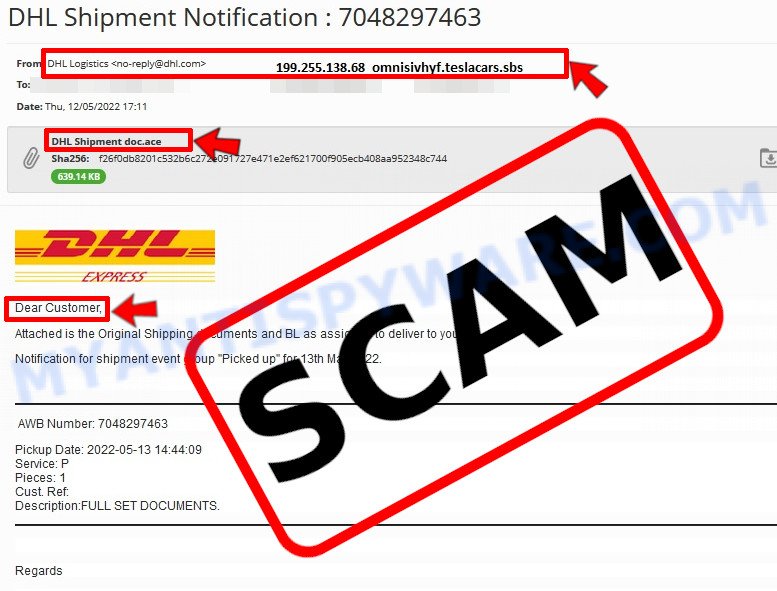
Here are some ways to recognize a phishing email
- Inconsistencies in Email Addresses. The most obvious way how to spot a scam email is finding inconsistencies in email addresses and domain names. If the email claims to be from a reputable company, like Amazon or PayPal, but the email is being sent from a public email domain, such as “gmail.com” it’s probably a scam.
- The domain name is misspelt. Look carefully for any subtle misspellings in the domain name. Like arnazon.com where the “m” has been replaced by “rn”, or paypa1.com, where the “l” has been replaced by “1”. These are common tricks of scammers.
- Generic greetings. If the email starts with a generic “Dear”, “Dear sir” or “Dear madam” that is a warning sign that it might not really be your shopping site or bank.
- Suspicious links. If you have the slightest suspicion an email may be a scam, do not click on the links you see. Instead, hover over the link, but don’t click it. This will pop up a small box that contains the actual URL. This works on image links as well as text links.
- Unexpected attachments. Email attachments should always be verified before clicking. Any attachments should be scanned for viruses – especially if they have an unfamiliar extension or one commonly associated with malware (.zip, .exe, .scr, etc.).
- The email creates a sense of urgency. Creating a false sense of urgency is a common trick of phishing emails. Be suspicious of emails that claim you must call, open an attachment or click a link immediately.
Report Scam Email
If you receive a scam email that is similar but not the same as the example above, make sure you remove any personal info in this message, then post it as comment on this article. This helps us to warn users about current scams, monitor trends and disrupt scams where possible.
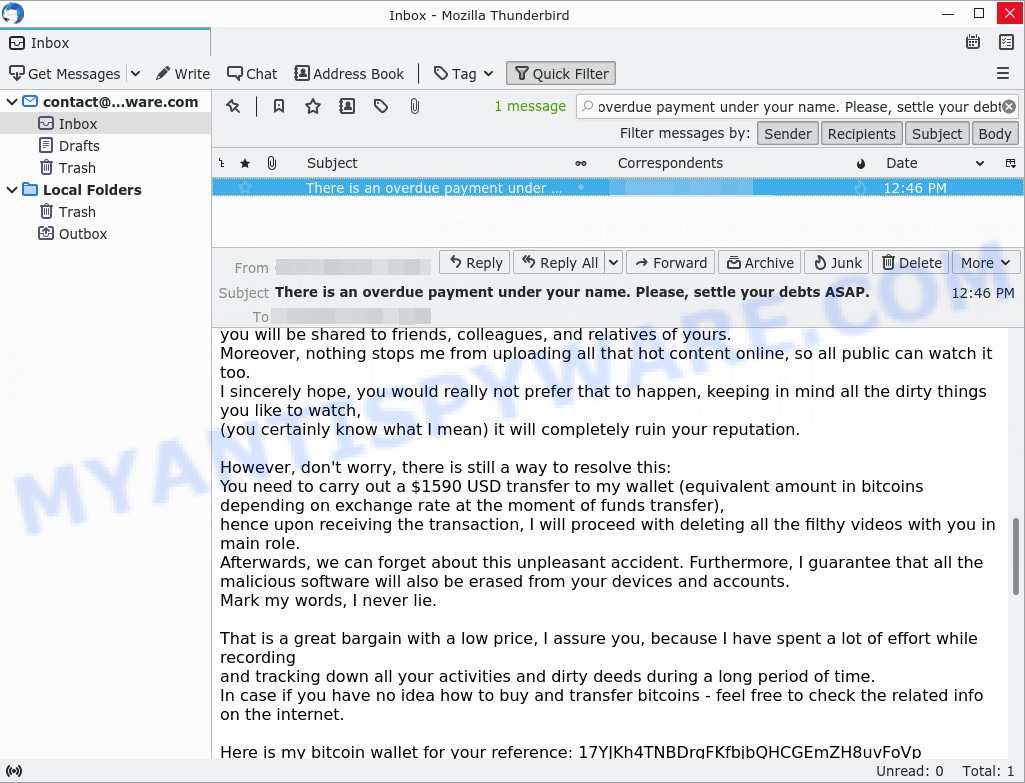
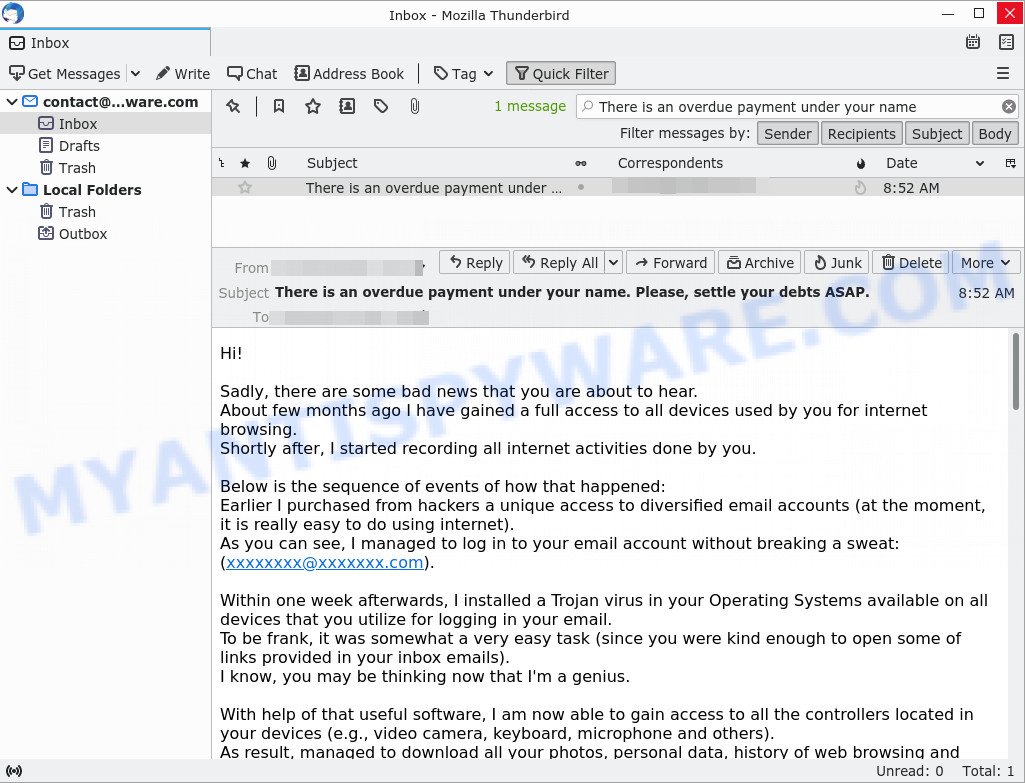
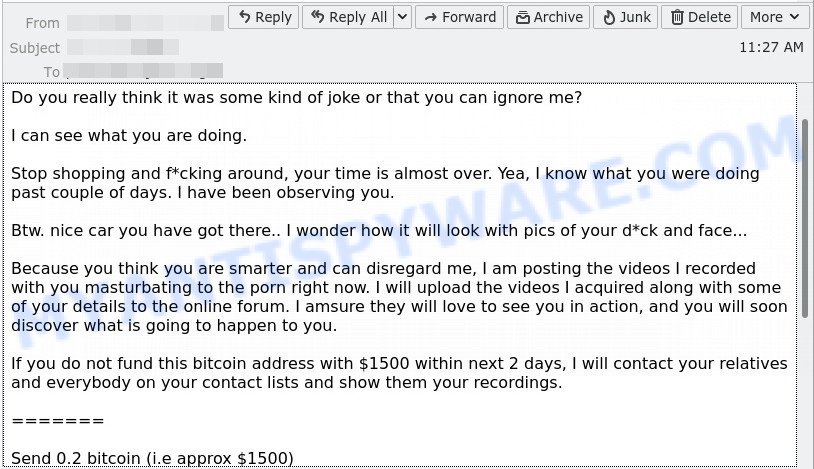
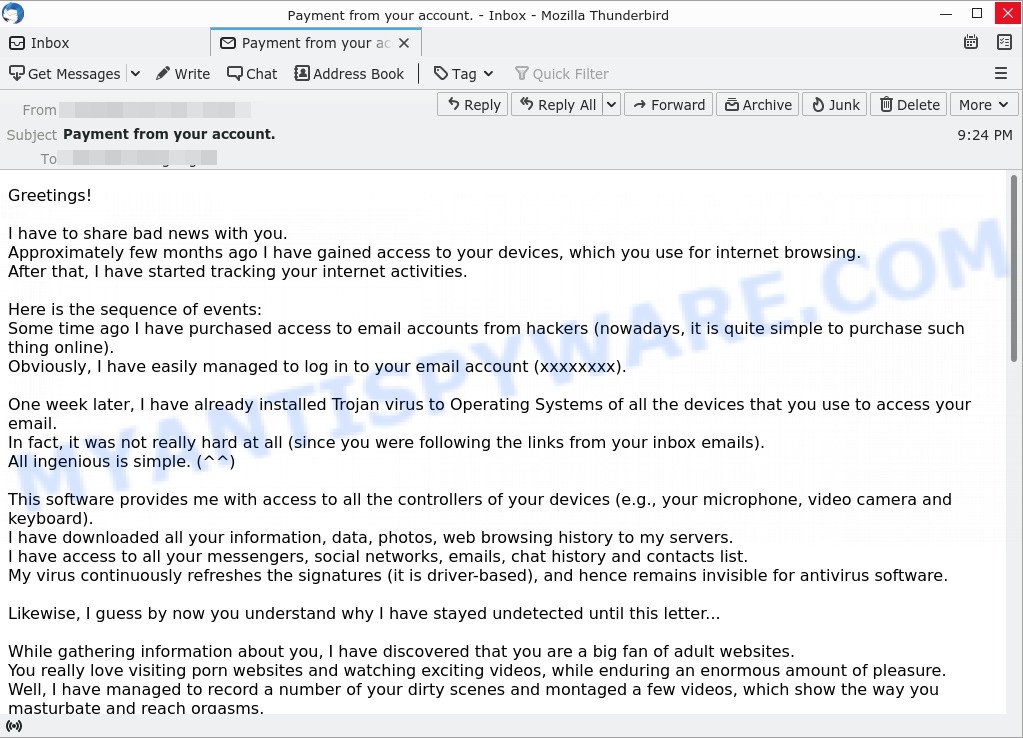


















I don’t need to introduce myself, as you can see, I’m a Hacker Anonymous X and I’ve full access to your device and operating system.
I’ve been successfully watching you for a very long time by infecting a malware through the adult site you visit regularly. My Spyware have also recorded a video of you masturbating and satisfying yourself and your activities with adolescence. I have full access to your address book and I’ll be very happy to share this interesting information to your contact list and social media contacts too.
To prevent this from happening, you’re hereby instructed to send R6, 000.00 through Spar / Checkers / Shoprite Money Market Counter or Capitec/Std Bank CashSend, take a photo of the transfer slip and email it with the 4 secret Digit PIN number to: adamspeter947@gmail.com
Quick tips: Do CashSend now or go to any Spar shops or Checkers / Shoprite with a copy of your ID Card to do it now.
Once I receive the compensation (Yes consider it as a compensation) I will delete the information immediately, and you will never hear from me again. I will receive a notification once this message is opened and the countdown will begin. I urge you not to Ignore this instruction and send it immediately to avoid complications.
Anonymous X.